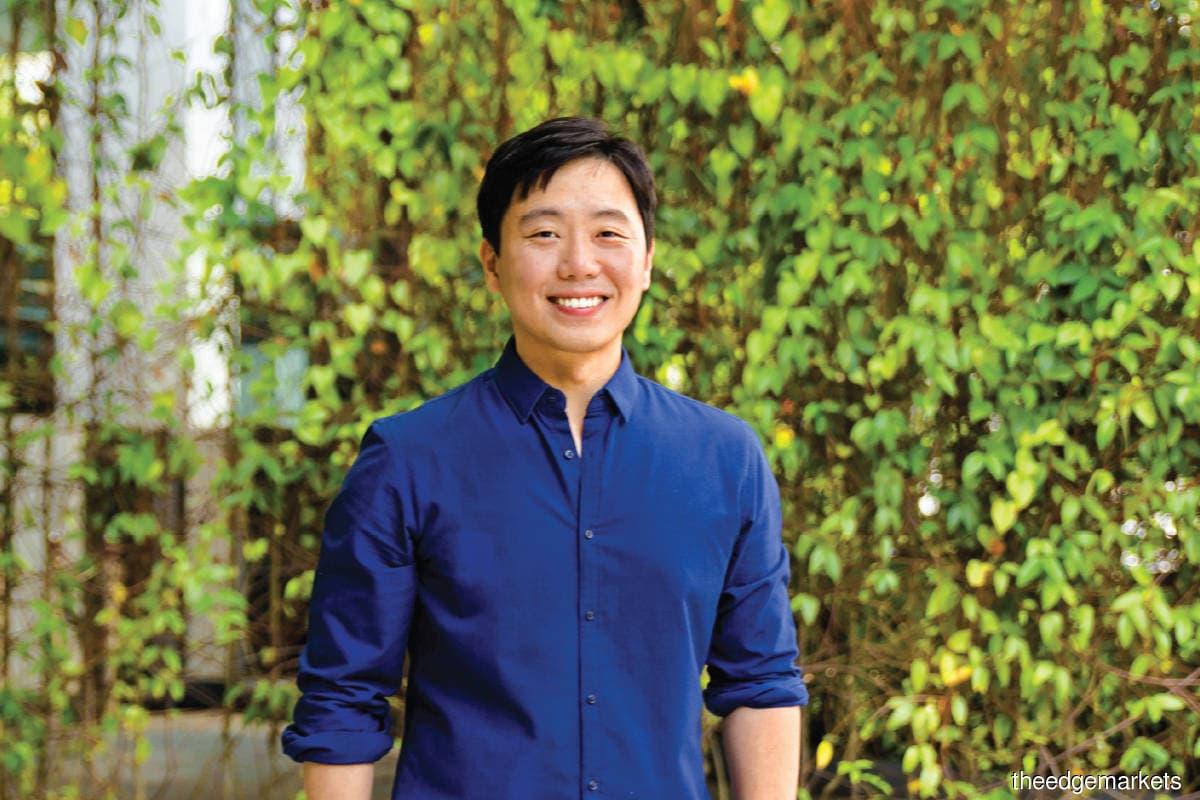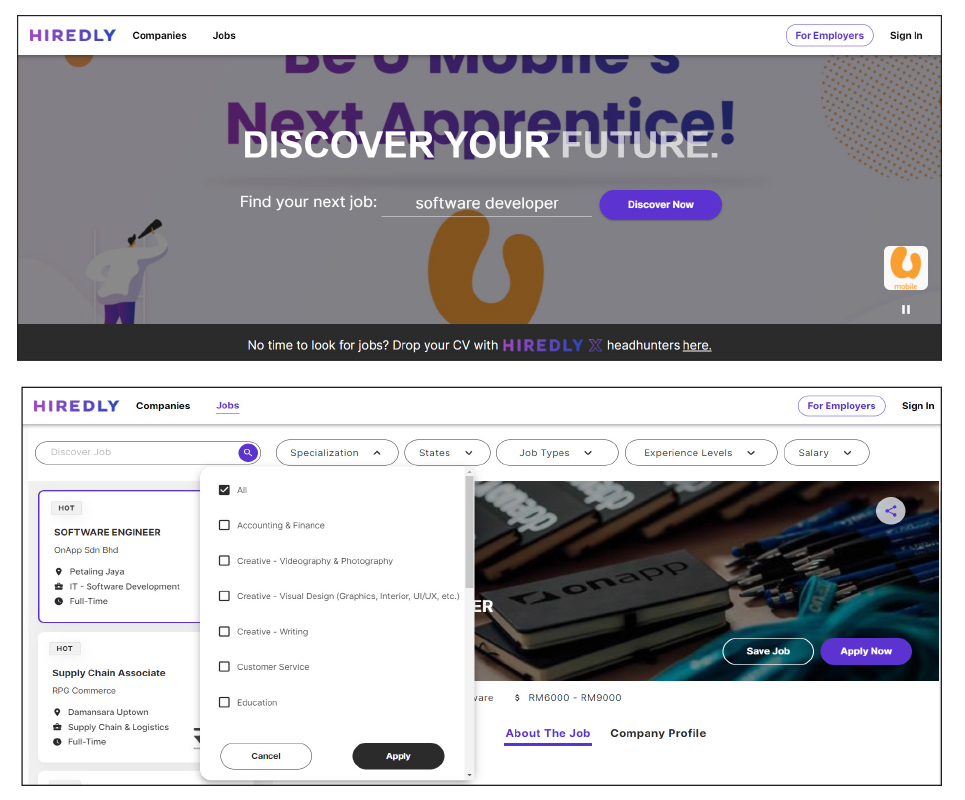
This article first appeared in Digital Edge, The Edge Malaysia Weekly on September 6, 2021 - September 12, 2021
Headhunting for talent has typically been a manual process. The hiring consultant goes through potential candidates’ curriculum vitae (CV) in a database, then calls them to inquire about their interest in joining a new company, observes Derek Toh, CEO and founder of hybrid recruitment platform Hiredly.
Toh has attempted to automate that process with artificial intelligence (AI) through Hiredly. Instead of having consultants make so many calls to understand the interest of potential candidates, he uses AI to assess the interest of users of the Hiredly job portal and headhunting platform.
For instance, say Employer A is interested in hiring a software developer. Hiredly’s AI will review users in its database to find those who have relevant skills, based on their CVs. Then, it will look through the users’ activities on the Hiredly job hunting platform.
Has the user been applying for software developer jobs? What kind of companies is he or she interested in?
“If you’ve applied to a lot of banks or oil and gas companies, we can tell what industries you’re interested in. The AI will also be informed every time you turn down a job offer on the portal. It will understand, for instance, if you have been saying no to a lot of oil and gas or tobacco companies,” says Toh.
The AI will then present a list of candidates — who have the skills and are potentially interested in Employer A — to the Hiredly headhunting consultant, who will then contact these people to further assess their interest. This effectively shortens the time headhunters take to find talents who are relevant and interested.
“We are trying to shortcut the sourcing and pre-screening process. Employers spend a lot of time looking through CVs and making phone interviews. AI can increase the speed of recruitment and we can offer our headhunting rates at very competitive prices,” says Toh.
Of course, this works only if the users are signed up to Hiredly’s headhunting service and use Hiredly’s job hunting portal actively. Otherwise, the interest element will not be captured by the AI. This recruitment automation solution was introduced in July, when Hiredly went through a rebranding exercise.
Can AI overcome human shortcomings?
What Toh is trying to do with the headhunting and recruitment space is disruptive. In general, hiring is a people-centric process. It requires a match of not just the candidates’ skills on paper but also their personality and values with the company. These things are often hard to observe and can be understood only through interactions.
A few other companies in Malaysia are also trying to disrupt this industry with technology. Adnexio, founded by former politician Rafizi Ramli, is an AI job-matching platform. Pulsifi uses technology to analyse data from candidates’ CVs and videos. It then provides companies with insights about a candidate’s experience and personality, among other things.
The business models differ slightly. Hiredly, which works with more than 16,000 employers, focuses mainly on junior to mid-level talent, and hosts both a headhunting and job-hunting platform. Adnexio seems to have only a job-hunting platform; and Pulsifi focuses on providing human resource solutions to companies.
Given that hiring is a people-based business, would using technology to do the pre-screening process result in a cookie-cutter approach, where only a certain type of candidate gets chosen?
Toh does not think so. For one, the human element is still prevalent in Hiredly, as the headhunting consultant and employer will make the final call. He also believes the AI adds to the diversity of candidates.
“Most matching AI just looks at the CV of a candidate and matches it to a job description. But CVs are based on past data. Capturing the interest of the candidates helps us flag more unconventional candidates,” says Toh.
“Say, for instance, there is someone who has been in a job for very long, has been promoted multiple times and works in a reputable company. This is a high-quality CV. But he applies for a digital marketing role, although his background is in general marketing.”
The AI would identify this person as a high-quality candidate but not as relevant. Here is where the third criterion of interest comes in. If the AI detects that this candidate has been applying to many digital marketing roles on Hiredly, it will assign the person a higher score and flag him as a potential match.
This circumvents the problem of hiring purely based on a candidate’s paper achievements. Some of the job openings on Hiredly include a chatbot, where candidates have to answer a few questions posed by the employer.
“On top of just looking at the CV, the employer can look at the answers from the chatbot. It allows candidates to stand out if their answers are good, even if the employer is not sure about their CVs,” says Toh.
Another problem often associated with the hiring process is implicit bias on the part of the employer, which influences the type of candidates found suitable. Could AI overcome that?
Toh explains that AI looks at only data and facts. It is trained by the shortlisting activities of employers on the job portal, so it can learn what the employer likes and does not like.
“Basically, if there is any bias at all, it would come from the human side, picked up through the shortlisting process. Our role is to always check whether the AI is being as objective as possible,” says Toh.
“The thing about algorithms is that it is a continual process. Every now and then, we have to review it and make sure it hasn’t picked up any ‘bad’ habits.”
Of course, Hiredly has no control over who an employer decides to hire. The most it can do is provide employers with candidates in an unbiased manner. Toh emphasises that one of Hiredly’s mission pillars is to improve the job seeker experience.
“We cannot win the long game if we do not take care of the job seeker’s experience. They have to love using us,” he says.
Hiredly will continue to explore how AI can be used to enhance its services. Currently, the AI does not understand the answers given to the chatbot. But existing technology could allow it to detect from the answers whether the candidate is a positive or negative person and check his language proficiency.
Toh says the company is not sure whether it wants to implement these applications yet. Its current use of AI in the headhunting and job portal market already puts it ahead of others, he believes.
Hiredly was rebranded from WOBB in early July to better capture its target market of professional junior to mid-level talents. Hiredly now comprises the job portal and Hiredly X, the headhunting platform. “This space is largely ignored commercially because there is not a lot of money that can be gained from helping a junior find a job,” says Toh.
Save by subscribing to us for your print and/or digital copy.
P/S: The Edge is also available on Apple's AppStore and Androids' Google Play.
